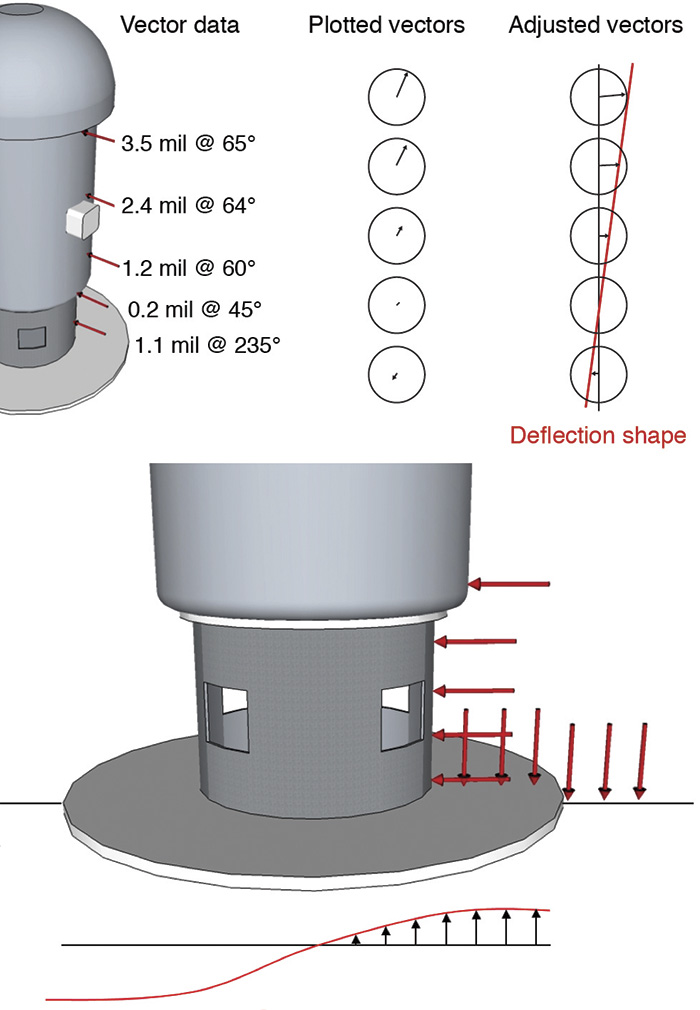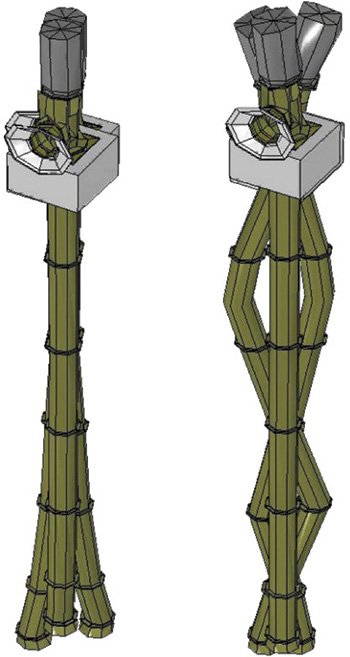The increasing use of variable speed drives has made resonance problems more prevalent.
EASA
03/01/2017
Structural vibration can be a problem with most machines, particularly with vertical turbine pumps. These pumps are commonly suspended from the discharge elbow with the motor mounted above, making them difficult to stiffen and damp. With low stiffness and damping, natural vibration frequencies in the machine operating range are inevitable, as well as reliability issues from excessive vibration. Fortunately, maintenance professionals lacking vibration analysis experience can resolve many of these issues if they understand the basics.
.jpg) Image 1. Vertical turbine motors mounted on isolation flexure plates(Graphics courtesy of EASA)
Image 1. Vertical turbine motors mounted on isolation flexure plates(Graphics courtesy of EASA)The Basics
All machine structures have natural frequencies at which they will easily vibrate. If someone bumps a metal stair railing, for example, it will vibrate at its natural frequency. If a nearby machine happens to rotate at that same frequency, the railing may vibrate violently in response to the slight vibration excitation from the machine. This commonly happens with vertical pumps. When slight vibratory forces from the pump operation excite the natural frequency of the pump structure, the pump is said to have a resonant condition. A natural frequency of any machine structure depends on its stiffness, mass and damping. Generally, stiffness and damping can be adjusted, but machine mass tends to be fixed. Damping is the ability of structural components to absorb vibration—to convert vibratory energy to small amounts of heat energy. Concrete has good damping properties, but metal does not. Increasing stiffness raises a natural frequency, while increasing mass lowers it. Changes in damping have minimal effect on the natural frequency. By absorbing vibratory energy, they can have a significant effect on the resulting vibration. The characteristics of stiffness, mass and damping explain why resonance is such a common problem on vertical turbine pumps. These are heavy machines (high mass) that are suspended with little support (low stiffness) and made mostly of metal (low damping), so the possibility of a resonance problem depends on how closely their natural frequencies match the rotating speed or other exciting frequencies. The increasing use of variable speed drives (VSDs) has made resonance problems more prevalent. When the rotating speed of a pump is adjusted through a range, it is likely to encounter a natural frequency, resulting in a resonant condition. Other circumstances that can cause resonance problems in a vertical turbine pump include:- deterioration of pump foundations and grouting
- changing a drive motor to a model with different mass characteristics
- seasonal temperature changes that affect discharge pipe loading
Diagnosing Problems
When a vertical turbine pump exhibits high vibration characteristics, it is important to analyze and diagnose the problem methodically before jumping to quick-fix solutions. This requires instrumentation and the ability to measure vibration amplitude and frequency. Measuring vibration phase angle can be helpful. The basic steps for diagnosing a resonance problem include:- Measure the frequency of the vibration. If the frequency does not match the rotating speed, the problem is likely something other than resonance such as cavitation, flow turbulence, a failing bearing or other mechanical issue.
- Perform a bump test. With the pump not running, bump the machine in the direction of greatest vibration and measure the frequency of the resulting vibration. As with the example of a metal stair railing, the pump will ring (vibrate) at its natural frequency. If that is within 15 percent of the operating speed, a resonant condition exists.
Corrective Measures
When basic analysis indicates a common pump problem such as cavitation, flow turbulence, mechanical looseness or a failing bearing, the corrections will be straightforward as on any other style pump. Cavitation can be corrected by raising the sump level or ensuring that the suction bell is not restricted. Mechanical problems with the machine usually require pump removal and repair. When a resonant condition has been diagnosed, the solution is seldom quick and easy, so attempts at quick fixes often fail. The natural frequency characteristics of vertical turbine pumps are complex, with many natural frequencies present and in varying directions, some of which will likely be within the pump’s operating range. While a resonant condition can be diagnosed with a simple bump test, any corrective measures should be undertaken cautiously. Without proper analysis, correcting a resonant condition on one direction or mode may just shift it to another. Besides the bump test, there are two other tests for diagnosing resonance: operating deflection shapes (ODS) and modal analysis. Modal analysis is a more sophisticated form of the bump test. Both modal analysis and bump tests are performed with the pump off and using an external exciting force like a mallet or shaker. Both indicate natural frequencies across the spectrum for comparison with rotating speed. ODS analysis shows the mode shape of the vibration at rotating speed and where to add stiffness to raise the natural frequency above the rotating speed. Figure 1. Operating deflection shape (ODS) analysis
Figure 1. Operating deflection shape (ODS) analysis  Figure 2. Modal analysis showing the first and second bending modes of the pump column
Figure 2. Modal analysis showing the first and second bending modes of the pump column
To read more Motors & Drives articles, go here.

